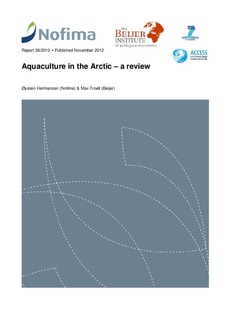| dc.contributor.author | Hermansen, Øystein | |
| dc.contributor.author | Troell, Max | |
| dc.date.accessioned | 2018-07-06T09:25:09Z | |
| dc.date.available | 2018-07-06T09:25:09Z | |
| dc.date.created | 2014-09-15T15:44:32Z | |
| dc.date.issued | 2012 | |
| dc.identifier.isbn | 978-82-8296-029-8 | |
| dc.identifier.uri | http://hdl.handle.net/11250/2504638 | |
| dc.description.abstract | Aquaculture in the Arctic region contributes with 2% of global production. This may seem small, but is of same magnitude as EUs total aquaculture production. Norway is by far the dominant producer in the Arctic. There is some activity in Iceland and Russia, while production in Sweden and Finland is very small. In the other Arctic countries we have not noted any activity. Production mainly constitutes of salmonids with additional limited production of a few other species. There is considerable uncertainty associated with the projections of future climate. This is also true for the Arctic region. Models predict increase in water temperature within the range of 0.5 to 2.5 degrees. Detailed impact studies for aquaculture are scarce, and even fewer analyse this from an Arctic perspective. The direct effects from a temperature change on the aquaculture industry can to some extent be modelled with fairly good accuracy, including both the effects on fish growth as well as how a whole industry may be affected. These models show how production will change and also socio-economic consequences. From these models it becomes clear that aquaculture in the Arctic will see positive effects from warming water temperatures. Other direct effects such as from storm frequencies and intensities can be relatively well anticipated, but the uncertainty regarding how these parameters will change is high. Other indirect effects such as diseases and pest species, freshwater runoff etc are very hard to predict, aggravating the uncertainty related to climate change. What is certain is that the environmental conditions will change and that the industry will have to adapt to these changes. For enabling the industry to do so there is a need to look over existing regulatory frameworks and start a multi-stakeholder dialogue to find out where and how aquaculture operations can move or change their operations. | |
| dc.description.abstract | Aquaculture in the Arctic – a review | |
| dc.language.iso | eng | |
| dc.publisher | Nofima AS | |
| dc.relation.ispartof | Nofima rapportserie | |
| dc.relation.ispartofseries | Nofima rapportserie | |
| dc.relation.uri | https://nofimaas.sharepoint.com/sites/public/_layouts/15/guestaccess.aspx?guestaccesstoken=xOGn%2bbhrPAs75bgQRJkw6OoE0HusOMFBHGPY9yRMddg%3d&docid=01090fa1fa43742a785ffb3f0539f9c7c | |
| dc.title | Aquaculture in the Arctic – a review | |
| dc.title.alternative | Aquaculture in the Arctic – a review | |
| dc.type | Research report | |
| dc.description.version | publishedVersion | |
| dc.source.pagenumber | 32 | |
| dc.source.issue | 36/2012 | |
| dc.identifier.cristin | 1154618 | |
| dc.relation.project | EU/265863 | |
| dc.relation.project | Nofima AS: 21204 | |
| cristin.unitcode | 7543,2,3,0 | |
| cristin.unitname | Næringsøkonomi | |
| cristin.ispublished | true | |
| cristin.fulltext | original | |
